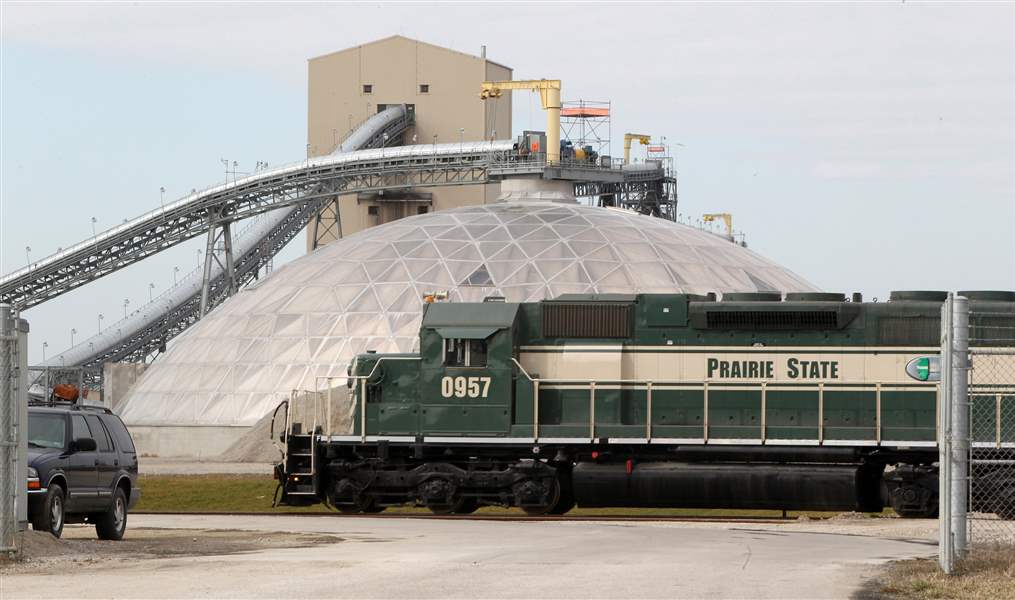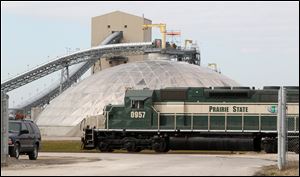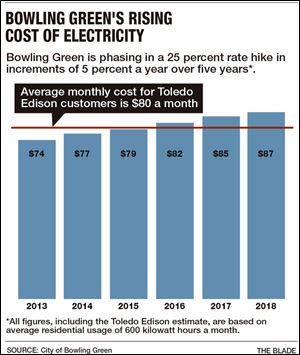
Electricity co-op gives B.G. a jolt
Rate increases spark concerns
4/21/2014
A diesel locomotive moves through the Prairie State Energy Campus facility in Belleville, Ill., with a domed storage unit in background. With annual rate increases of 5 percent planned through 2019 — costing homes and businesses 25 percent more five years from now — some people are questioning how much faith Bowling Green should maintain in a controversial coal-fired power complex in southern Illinois.
BELLEVILLE NEWS-DEMOCRAT

A diesel locomotive moves through the Prairie State Energy Campus facility in Belleville, Ill., with a domed storage unit in background. With annual rate increases of 5 percent planned through 2019 — costing homes and businesses 25 percent more five years from now — some people are questioning how much faith Bowling Green should maintain in a controversial coal-fired power complex in southern Illinois.
BOWLING GREEN — The question isn’t whether Bowling Green’s electricity costs will rise, but why.
With annual rate increases of 5 percent planned through 2019 — costing homes and businesses 25 percent more five years from now — some people are questioning how much faith Bowling Green should maintain in a controversial coal-fired power complex in southern Illinois. Bowling Green has partially funded that power complex through its association with Columbus-based American Municipal Power Inc., an electric co-op owned and governed by 129 member communities in Ohio and five other states.
AMP negotiated ownership of 23.2 percent of the $5 billion Prairie State project for 68 of its member communities, including Bowling Green and Napoleon.
Brian O’Connell, Bowling Green utilities director, attributes the city’s planned rate increases to a 133 percent jump in capacity charges by PJM Interconnection LLC, a regional transmission organization that maintains the electric grid for all or parts of 13 states and the District of Columbia.
He also cites construction and start-up costs of four new hydroelectric projects that AMP is developing along the Ohio River. They are in addition to two existing ones.
Mr. O’Connell said he remains unfazed by the Prairie State project’s $1 billion in cost overruns.
“We still view it as a good, long-term asset for the city and our energy portfolio,” Mr. O’Connell said. “Prairie State is not the driver of these increases.”
But watchdogs are questioning whether Bowling Green is overlooking or downplaying the impact of the city’s 2007 decision to become a Prairie State investor.
Call for inquiry
Citizens for a Livable Future, a local nonprofit organization, and the Cleveland-based Institute for Energy Economics and Financial Analysis are calling upon regulators to investigate.
Neocles Leontis, a Bowling Green State University chemistry professor and Citizens for a Livable Future member, said the city’s investment in Prairie State “is turning out to be an economic disaster.
“We don’t blame Bowling Green,” Mr. Leontis said. “We blame AMP.”

Sandy Buchanan, executive director at the Institute for Energy Economics and Financial Analysis, said her group has implored Ohio Attorney General Mike DeWine to investigate AMP.
The city’s largest energy user, Bowling Green State University, declined to address the Prairie State situation.
“We simply can’t speculate on future utility rates or the potential effect on the University,” Dave Kielmeyer, BGSU spokesman, said in a prepared statement.
Three BGSU officials involved in managing the university’s utilities also declined to comment.
BGSU pays some of the highest electric rates among Ohio public universities. A Dec. 11 consultant’s report said the university needs to engage city leaders “in discussions around opportunities to achieve a more equitable electricity rate.” Critics fear what might happen if the costs of producing power at Prairie State keep going up.
Prairie State was developed by Peabody Energy, America’s largest coal company. Located in Marissa, Ill., the site has two, 800-megawatt units. Their potential combined generation of 1,600 megawatts is enough to meet the energy needs of 1.6 million homes.
The units operated at only a combined 58 percent capacity from June, 2012, through January, 2014. That’s far below the site’s operational goal of 85 percent capacity, according to a Feb. 28 letter sent to Illinois State Attorney General Lisa Madigan by Timothy L. Schmitz, deputy Republican leader of the Illinois House of Representatives.
In that letter, Mr. Schmitz said the project is being investigated by the U.S. Securities and Exchange Commission. The letter also alluded to the requests that Mr. DeWine’s office investigate.
Mr. DeWine’s spokesman, Dan Tierney, said any ongoing investigations would not be confirmed or denied.
Bowling Green is one of 217 municipalities from eight utility consortia, most of them east of the Mississippi River, that became Prairie State’s part-owners. It exposed itself to more risk than many other cities, committing itself to a 35-megawatt share.
Last year, Bowling Green got 38 percent of its electricity from Prairie State. In 2016, it is expected to get half of it from that complex, according to a consultant's report.
Large investment
Bowling Green’s investment in the Prairie State project is the largest among Ohio communities, more than seven times the 4.976 megawatts Napoleon agreed to take on. It is almost 10 percent of AMP’s 368-megawatt share in the project.
AMP recommended that level of investment for Bowling Green, but so did an independent consultant the city hired, Mr. O’Connell said.
“I don’t think there was anything illegal or nefarious or misrepresented,” he said.
He said Bowling Green was attracted to the Prairie State project because of its need for power that can be reliably generated 24 hours a day, known as baseload power.
Most of that is done by coal, nuclear, and more recently, natural-gas plants.
AMP’s Fremont Energy Center, which operates on natural gas, has quickly become an attractive option for many of AMP’s member communities.
But not Bowling Green.
The Fremont Energy Center didn’t come online until January, 2012, after Bowling Green was heavily invested in Prairie State.
“Prior to Prairie State and [AMP’s upcoming additional projects in] hydro, we were heavily exposed to the open market,” Mr. O’Connell said. “Natural gas hadn’t really come into play at that point.”
Prairie State is what’s known as a mine-mouth complex, an all-in-one project developed on the site of a Peabody coal mine, which allows investing communities to co-own both the plant and its fuel.
The plant’s waste is buried on-site, which supporters believe also will yield long-run savings.
Critics accuse Peabody of concocting a deal to reap profits from a coal mine with limited value because of coal’s high sulfur content.
Peabody has sold all but 5 percent of its shares in the power plant. It did not respond to requests for an interview.
Other rate hikes
The Chicago Tribune has reported that numerous communities — especially small ones in Illinois — have been socked by rate increases because of their heavy investment in the project.
Napoleon relies on Prairie State for 20 to 25 percent of its electrical needs, Napoleon City Manager Jon Bisher said.
No rate increases are planned now, although Mr. Bisher said Napoleon’s rates are getting a periodic review by an outside consultant.
Napoleon has weathered Prairie State’s cost overruns because of how much better the city’s other energy sources have performed — especially the Fremont Energy Center, he said.
“Always, there are times when some things are doing better and some things are doing worse,” Mr. Bisher said, likening investments in energy to investments in the stock market.
Kent Carson, an AMP spokesman, said the co-op would not consent to an interview, but four company executives defended AMP at Bowling Green’s most recent Board of Public Utilities meeting.
Marc Gerken, AMP’s president and chief executive officer, said the new hydro projects will be a solid investment because they have low operating costs.
Mike Perry, AMP’s senior vice president for generation, said Prairie State is one of the nation’s largest coal-fired facilities built since 1982.
In a five-page statement submitted to The Blade, AMP’s public-relations department said Prairie State “remains in a shakedown process,” meaning that operators are working out technological challenges posed by modern pollution-control technology.
Few new coal plants are being developed because of costs associated with controlling their heavy pollution.
AMP tried developing a coal-fired power plant in southern Ohio’s Meigs County, then canceled the project in 2009 because of cost overruns.
Bowling Green was one of the investors in that project, and now is incurring more costs because of it. On March 31, a federal judge rejected AMP's attempt to recover nearly $100 million from the lead contractor, Bechtel Corp.
Coal produced half of the nation’s electricity for years, but it is now the fuel for less than 40 percent, its lowest market share since at least 1949.
Markets have shifted away from coal because of tougher pollution regulations and the steep decline in natural gas prices from fracking, industry analysts say.
Bowling Green has branded itself as a proponent of renewable energy since the city worked with AMP to become Ohio’s first recipient of industrial-scale wind turbines.
Four 1.8 megawatt turbines at the Wood County landfill — two erected in 2003, followed by another pair in 2004 — collectively provide only about 1 percent of Bowling Green’s electrical needs.
But former Bowling Green Mayor John Quinn said at a 2004 dedication he considered them more famous than Bowling Green native Scott Hamilton’s figure-skating gold medal during the 1984 Winter Olympics.
Another speaker referred to the city as “Blowing Green,” while someone else told the crowd the Wood County landfill may be the only dump that’s become a tourist attraction.
Bowling Green has no space for more wind turbines, but Mr. O’Connell said the city is considering more solar power.
While critics charge Bowling Green hasn’t kept up its commitment to renewable energy, the utilities director said the city’s heavy coal investment isn’t as contradictory as it might appear.
When the new AMP hydro projects come online in 2015 or 2016, Bowling Green will get 37 percent of its electricity from renewable energy sources, he said.
Under a 2008 state law, Ohio utilities are required to generate at least 12.5 percent of their electricity from renewable sources by 2025.
“I would challenge anybody to say that by 2015 they will be 37 percent renewable,” Mr. O’Connell said.
Contact Tom Henry at: thenry@theblade.com or 419-724-6079.